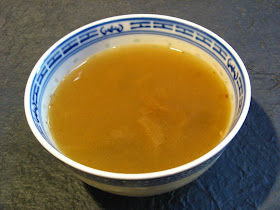Soup stock is always made from bones, so the name of this
dish is just my way of naming a most basic dish with a cute name. My sister and
I were joking about growing up with a freezer half filled with bones to make
soup stock. While there’s some truth to that, I don’t remember my parents ever
having to buy bones in the market to make soup. As dishes were prepared, rather
than being discarded, the bones were saved in the freezer. So unless you
specifically want to make a particular soup (e.g. pork soup), you just use the
collection of bones from the freezer to make soup.
I have the same habit of saving my bones in the freezer and
then using them to make soup. So this recipe doesn’t produce the clear broth
that is characteristic of a single species stock (e.g. using just chicken bones
to make a clear stock), but is a rich collection of proteins leached from a
variety of bones that are boiled together with some ginger and garlic. Now I
know that doesn’t sound very appetizing, but it’s an apt description of making
soup stock.
When making the soup stock, scum and oil from the bones will
float to the top of the liquid. You can be obsessive and remove scum and oil as
it rises while the pot comes to a boil, but I’ve found that you can wait until
the soup stock boils in a covered pot and then remove the scum and oil. As a
result of removing the scum and oil, the level of the liquid will go down in
the pot. I just add some boiling water to restore the level of the liquid in
the pot, so make sure that you have some boiled water available in a water
kettle. As the soup stock cooks, the level of the liquid might also go down, so
this method can also be used to restore the level of liquid in the pot. Not a
lot of boiling water in total gets added, so taste of the soup stock is not
affected.
I don’t add any salt when making the soup stock. Salt can be
added, if necessary, when cooking the ultimate dish in which the bone soup will
serve as the stock. Some salt comes from the preserved mustard stalk, actually
half a stalk, which I use to make the bone soup. The addition of the preserved
mustard is my way of introducing a slight sweetness to the stock and no one
will ever know that the ingredient was ever used. I guess it’s my secret for
making tasty soup (well, not anymore). I used to use a whole stalk when making
soup stock (there are two stalks per package), but the center of the stalk
never got cooked through. Cutting a stalk lengthwise and using half a stalk,
the mustard green gets cooked thoroughly and the taste of the soup stock is the
same.
Enjoy!
Ingredients
Instructions
|
10 lb.
|
4.5 kg.
|
(Approximate weight) Beef, pork, and chicken bones
|
|
½ stalk
|
½ stalk
|
Preserved
mustard (梅菜, mui4 coi3)
|
|
1 in.
|
30 mm.
|
Knob of ginger
(薑, goeng1), peeled and crushed lightly
|
|
4 cloves
|
4 cloves
|
Garlic (蒜, syun3), crushed lightly
|
|
|
|
Water
|
|
|
|
Boiling water
in a water kettle
|
Equipment
|
|
|
Water kettle
|
|
16 qt.
|
15 L.
|
Covered pot
|
|
|
|
Spoon or other utensil to skim the fat from the pot
|
|
|
|
Slotted spoon or other utensil to remove the bones
from the pot
|
|
4 qt.
|
3.8 L.
|
Covered bowls (x 2) to store the finished stock
|
Instructions
Using a 16 qt. (15 L.) pot will produce approximately 8 qt. (7.5 L.) of stock.
Boil water in a separate water kettle.Preserved Mustard (梅菜, mui4 coi3) - Cut one stalk of the preserved mustard in half lengthwise. Place the cut mustard green into the pot. Put the bones into the pot, mostly filling the pot with the bones. Put cold water into the pot to cover the bones and then place the lid on the pot.
- Place pot over high heat and bring the pot to a boil. Uncover the pot once the contents are boiling, reduce the heat to low to simmer, and use a spoon or equivalent utensil to skim the scum and oil from the surface of the liquid. The level of the liquid will go down as the result of the removal of the scum and fat, so the pot can be refilled with more boiling water from a water kettle to restore the amount of liquid in the pot.
- Add the ginger and garlic, recover the pot, and allow to simmer on low heat for 4-6 hours. If the level of the liquid falls too far, boiling water can be added from a water kettle.
- At the end of the cooking time, turn off the heat, remove the pot from the heat source, and uncover. Use a slotted spoon or equivalent utensil to remove the bones, ginger, and garlic from the stock and discard them. The preserved mustard, which will still be intact, can be kept and eaten later as part of a soup dish, or can be discarded.
- Use a clean spoon or equivalent utensil to remove as much of the fat floating on the surface of the stock. Put the stock into covered bowls, allow to cool, and then store covered in the refrigerator overnight. After refrigerating overnight, remove any solidified fat that formed on the surface of the stock with a clean spoon or equivalent utensil.


No comments:
Post a Comment